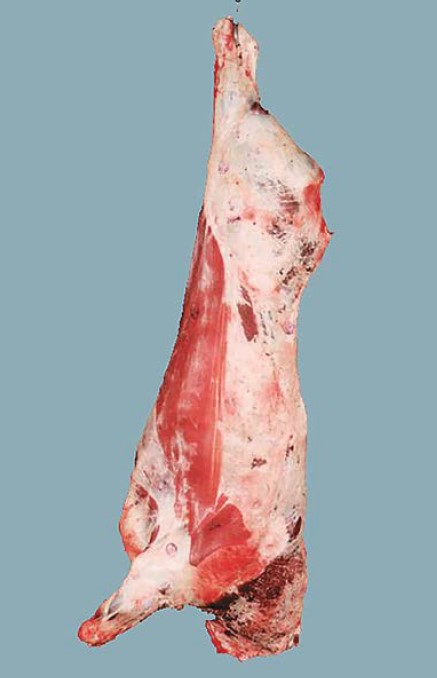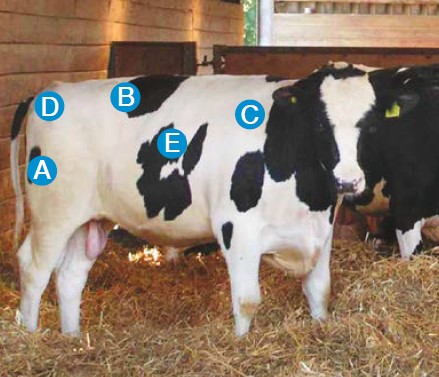- Home
- Knowledge library
- How to select dairy beef cattle for slaughter
How to select dairy beef cattle for slaughter
Beef carcase in the UK is classified according to an animal’s conformation and fat levels. Learn how to select dairy beef cattle for slaughter and see our handling guidance to maintain the quality of meat.
Back to: How to manage dairy beef production
About beef carcase classification
The current classification system for beef carcases in the UK and Europe combines both:
- The European Union’s EUROP grid for conformation
- A numeric assessment for fatness (classes 1–5)
The most suitable market for each type of carcase is determined by combining the scores for both conformation and fat.
For the best returns, most dairy beef cattle should fall into:
- The O area for conformation
- Fat class 3
An example of a carcase with an O classification is shown in the photo.
Holstein cattle tend to have smaller muscles and deposit more marbling and less external fat than most beef breeds. They also have a lower killing-out percentage due to a lower muscle to bone ratio and higher kidney and pelvic fat content.
How to assess cattle’s readiness for market
Weight and visual appraisal are general guides to an animal’s readiness for market to ensure accurate selection; handling the live animal is essential.
Main indicators of conformation and fat level
The five key handling points shown in the image of the dairy beef bull give the best indication of the level of finish and fat class. They combine reliability with ease of access.
To assess conformation of a bull, feel the animal at:
- A –the round or hindquarter
- B – the loin
- C – the shoulder
To assess fat level, feel the animal at:
- D – the pin bones and either side of the tailhead
- B – the loin (transverse processes)
- E – the ribs

O grade beef carcase

Main indicators of conformation and fat level
How to assess conformation in dairy cattle
To gauge an animal’s conformation, you need to consider the:
- Depth and thickness of the round
- Fullness of the loin
- Thickness of the flesh over the shoulder
Learn more about assessing conformation in beef cattle.
How to assess fatness in dairy cattle
Handle animals over the loin on the left side as seen from behind. Use just the tips of fingers to feel fat depth over the underlying muscle and bone at each of the handling points.
Be aware that large amounts of kidney fat on the right-hand side can be misleading in assessing fat cover.
As animals get fatter, the ends of the transverse processes (bones) over the loin and pin bones, as well as the shoulder blade ridge, become more rounded.
The hollows between the ribs and shoulders fill up completely at the highest fat levels.
Hide thickness varies with breed. Consider this when assessing fatness, particularly over the tailhead, loin and ribs.
Learn more about assessing fatness in live beef cattle.
Handling dairy cattle
Sensitive handling is vital for animal welfare and avoids damage that shows up after slaughter.
Bruising and abscesses lead to wasteful trimming and even partial condemnation of the carcase, which in turn reduces carcase saleability and your returns.
You can avoid potential losses associated with poor handling by:
- Handling cattle in races with smooth walls, non-slip floors and gradual ramps
- Not using sticks or goads
- Not overcrowding animals in vehicles and by using internal partitions to restrict movement while travelling
- Using clean injection needles to avoid infection
- Choosing injection sites with care
- Separating horned and non-horned cattle
How to avoid dark cutting meat
Dark cutting beef – where the meat looks an unattractive deep red colour – can occur in all types of cattle.
With a reduced shelf life, a carcase you sell that is classed as dark cutting meat will be devalued.
Also referred to as ‘dark firm dry’ (DFD), dark cutting meat is usually caused by stress in the 24–48 hours before slaughter, and is more common in young bulls.
You can avoid stress pre-slaughter and avoid DFD by doing the following:
- Always handle animals quietly
- Avoid mixing cattle from different groups
- Provide clean, dry bedding and plentiful water in any holding pens or lairage
Useful links
See our beef diseases directory for more details about the conditions that can affect cattle
Access the ‘Dairy beef production systems' manual, for further practical advice
If you would like to order a hard copy of the Beef diseases directory or the Dairy beef production systems manual, please contact publications@ahdb.org.uk or call 0247 799 0069.

